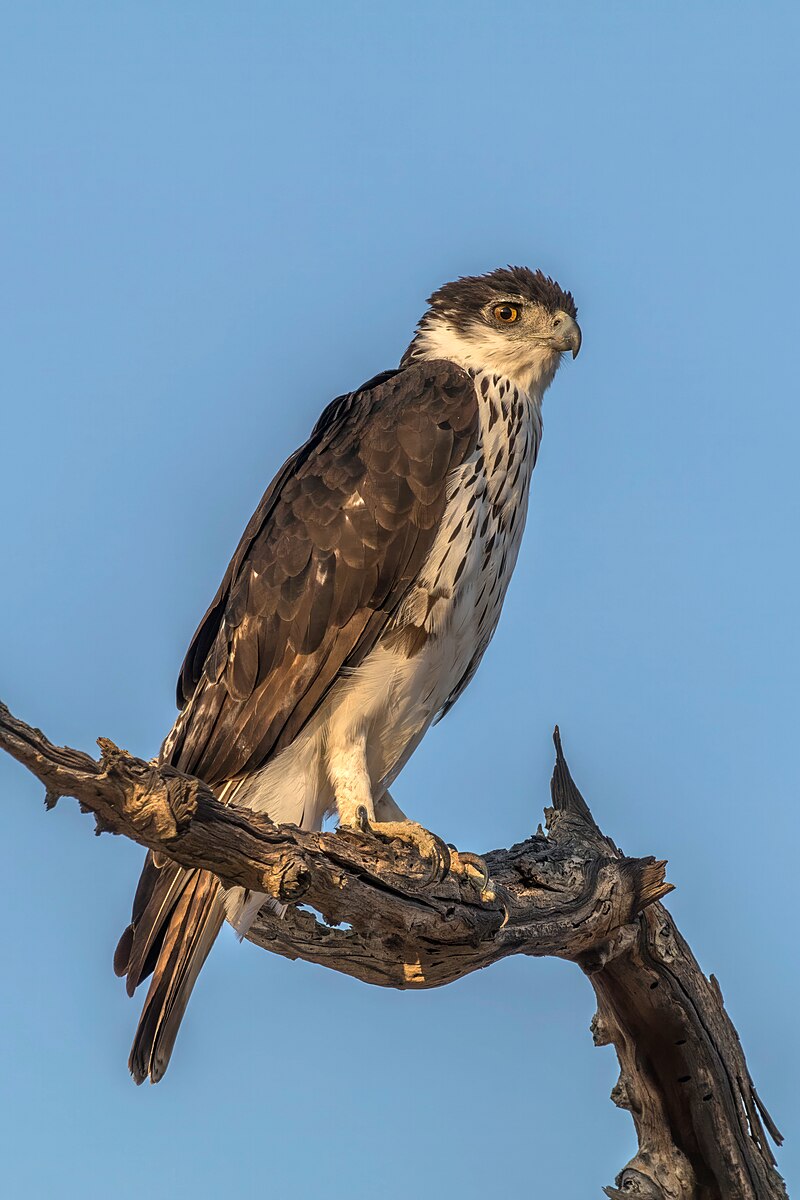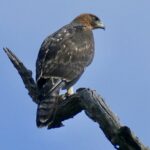African hawk eagles (Aquila spilogaster) are not typically black, but rather a mix of blacks, whites, and grays. However, juveniles have a moderately dark brown coloration above with some pale edging, a slightly black-streaked head, and a more clearly barred tail than adult hawk-eagles.
Appearance of African Hawk Eagles
African hawk eagles are medium-sized birds of prey, reaching lengths of 22-26 inches (56-66 cm) and weighing 3.3-4 lb (1.5-1.8 kg). They have a slim body and head like a hawk, with distinctive white and black streaked underparts resembling an eagle. The underwing feathers are predominantly white with a black edge, and the underwing coverts are predominantly black with white patches. The upper parts of the body are mostly blackish, with slight variations of white spots or brown areas.
Juvenile African hawk eagles are predominantly brown with rufous (brownish-red) coloration on the underparts, which turn black with age. Both male and female African hawk eagles look similar, but some studies suggest that female birds have heavier markings on their feathers than males, and females are generally larger than males.
Habitat and Distribution
 Image source: African hawk-eagle by Charles J. Sharp
Image source: African hawk-eagle by Charles J. Sharp
African hawk eagles are found in tropical Sub-Saharan Africa, primarily in dry, woodland habitats, open savannas dotted with trees, and riparian forests. They are relatively small, diurnal, non-migratory birds of prey that play a vital role in their environment as top predators and umbrella species.
Behavior and Aggressiveness
Little is known about the behavior and aggressiveness of African hawk eagles towards humans. However, they are highly unpredictable, and it is not recommended to approach them or their nests. African hawk eagles are territorial and may exhibit aggression if they feel their eggs or juveniles are threatened.
Conservation
Although the African hawk eagle is widespread throughout its range and categorized as a species of Least Concern, it still faces serious threats such as habitat loss, poisoning from carcasses intended for large predators, and persecution by farmers due to predation on domestic fowl. The Peregrine Fund is working to conserve this species through scientific research, habitat conservation, education, and community development.
Key Facts about African Hawk Eagles
| Fact | Value |
|---|---|
| Scientific Name | Aquila spilogaster |
| Length | 22-26 inches (56-66 cm) |
| Weight | 3.3-4 lb (1.5-1.8 kg) |
| Habitat | Dry, woodland habitats, open savannas, riparian forests |
| Distribution | Tropical Sub-Saharan Africa |
| Coloration | Mostly blackish upper parts, white and black streaked underparts |
| Juvenile Coloration | Predominantly brown with rufous underparts |
| Conservation Status | Least Concern |
| Threats | Habitat loss, poisoning, persecution by farmers |
In conclusion, African hawk eagles are not typically black, but rather a mix of blacks, whites, and grays. Juveniles may have a darker brown coloration, but the adults exhibit the distinctive white and black streaked appearance. These birds play a crucial role in their ecosystems, and conservation efforts are underway to protect them from various threats.
References
- https://www.africawild-forum.com/viewtopic.php?t=10349
- https://peregrinefund.org/explore-raptors-species/eagles/african-hawk-eagle
- https://operationmigration.org/african-hawk-eagle-the-ultimate-guide/
- https://ebird.org/species/afrhae1
- https://animalia.bio/african-hawk-eagle/1000


